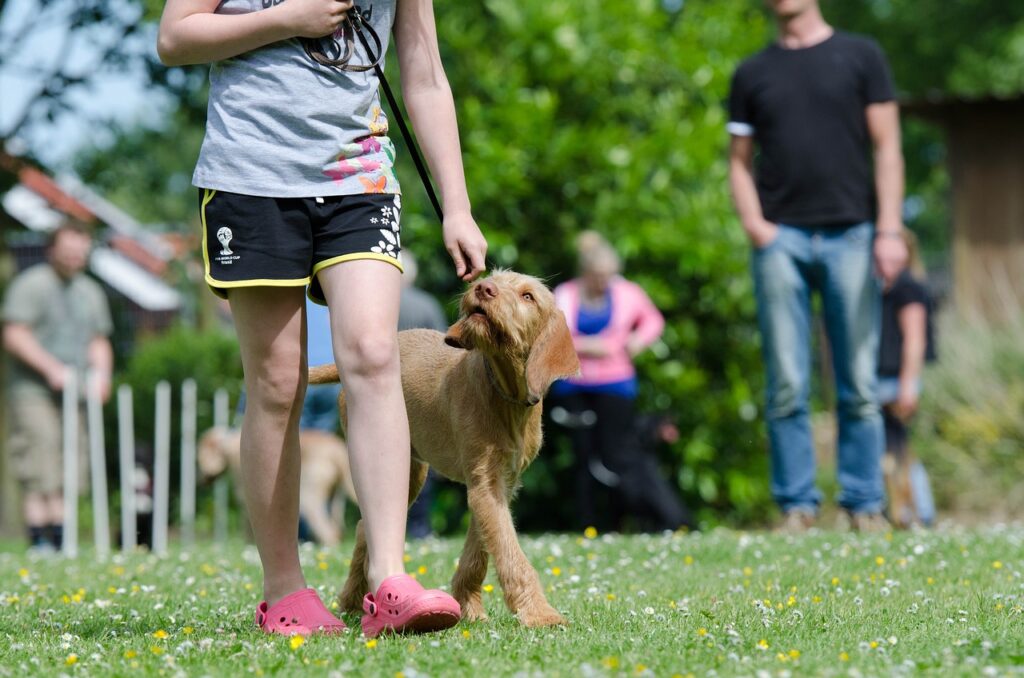
So, you’ve got a new furry companion and you can’t wait to start exploring the great outdoors together. But there’s just one teeny tiny problem – your pup treats the leash like their arch nemesis, always pulling and tugging to the point of chaos. Well, fear not! In this article, we’ll share some tried and tested techniques that will have your four-legged friend walking politely by your side in no time. From positive reinforcement to consistency, we’ve got all the tips and tricks to help you and your canine friend enjoy peaceful, enjoyable walks together.

This image is property of pixabay.com.
Choosing the Right Leash and Collar
Selecting the Right Leash
When it comes to choosing the right leash for your furry friend, there are a few factors to consider. First, think about the size and strength of your dog. For smaller dogs, a lightweight and retractable leash may be suitable. However, for larger and more powerful breeds, a sturdy and non-retractable leash is recommended to ensure both control and safety. Additionally, the length of the leash is crucial. A standard leash length of 4-6 feet allows for optimal control during walks. Lastly, consider the material of the leash. Nylon leashes are durable and easy to clean, while leather leashes provide a classic and stylish look.
Choosing the Right Collar
Selecting the right collar for your dog is essential for their comfort and safety. There are various types of collars available, including flat collars, martingale collars, and choke collars. Flat collars are the most common and suitable for most dogs, while martingale collars are designed for dogs with narrow heads such as Greyhounds. Choke collars should be used with caution and only under the guidance of a professional trainer. Whichever collar you choose, ensure it fits properly by allowing for two fingers to comfortably fit between the collar and your dog’s neck.
Considering Harnesses vs. Collars
While collars are the traditional choice for leash attachment, harnesses can be a great alternative, especially for dogs that tend to pull or have neck sensitivities. Harnesses distribute the pulling force across the chest and shoulders, reducing the strain on the neck. There are different types of harnesses available, such as front-clip harnesses and back-clip harnesses. Front-clip harnesses are effective in discouraging pulling behavior, as they direct the dog’s attention towards you. Back-clip harnesses provide more freedom of movement for well-behaved dogs. Consider your dog’s behavior and needs when deciding between a collar and a harness.
Introducing the Leash and Collar
Allowing Familiarization Time
Before you start training your dog to walk on a leash, it’s important to allow them some time to get familiar with the leash and collar. Let your dog sniff and investigate the new equipment, and associate it with positive experiences. Toss treats near the leash and collar, and praise your dog whenever they show interest or come close to them. This will create a positive association, making the leash and collar an exciting and rewarding part of their routine.
Positive Association with Leash and Collar
To further reinforce the positive association, attach the leash and collar to your dog while they are indoors. Allow them to move around freely, praising and treating them for wearing the equipment. Gradually increase the duration of wearing the leash and collar, making sure your dog feels comfortable and relaxed. This step is crucial for establishing a positive connection between your dog and their leash, setting the foundation for successful leash training.
Teaching Basic Commands
Teaching ‘Sit’ Command
One of the essential commands for walking on a leash is the ‘sit’ command. Start by holding a small treat in your hand, and let your dog smell it. Slowly move your hand upwards, leading their nose towards the sky. As your dog follows your hand, their bottom will naturally lower to the ground in a sitting position. The moment their bottom touches the floor, say “sit” and reward them with the treat. Consistently practice this command in different locations and gradually reduce the need for treats, relying more on verbal praise and physical affection.
Introducing ‘Stay’ Command
Once your dog has mastered the ‘sit’ command, it’s time to introduce the ‘stay’ command. Start with your dog in the sitting position and give them the cue to sit. Once they are sitting, take a step back while keeping eye contact with them. If they remain in the sitting position, praise them and give them a treat. If they move, calmly bring them back to the sitting position and repeat the command. Gradually increase the distance and time you ask your dog to stay, always rewarding them for successfully staying in place.
Positive Reinforcement Training
Using Treats for Reward
Positive reinforcement is a highly effective training method that utilizes rewards to reinforce desired behaviors. Treats can be a powerful motivator when training your dog to walk on a leash. Keep a supply of small, soft treats handy during your training sessions. Whenever your dog exhibits good leash behavior, such as walking calmly beside you, provide them with a treat and praise them. This positive association will encourage them to repeat the desired behavior, making leash training a positive and enjoyable experience for both of you.
Effective Clicker Training
In addition to using treats, clicker training can be a valuable tool for leash training. A clicker is a small device that makes a distinctive sound. Pair the clicker sound with treats by clicking and immediately offering a treat. Use the clicker to mark the desired behavior, such as walking without pulling, and reward your dog accordingly. The sound of the clicker becomes a signal that your dog has performed the desired behavior and can expect a treat. With consistent clicker training, your dog will quickly associate the sound with positive reinforcement and learn to walk politely on a leash.
Verbal Praise and Affection
While treats and clicker training are effective, don’t underestimate the power of verbal praise and affection. Dogs thrive on positive attention from their owners, and verbal encouragement can be just as rewarding as treats. During your leash training sessions, use uplifting words such as “good job” or “well done” to acknowledge and reward your dog for their efforts. Combine verbal praise with physical affection, such as gentle pats or a belly rub, to strengthen the bond between you and your furry companion.

This image is property of pixabay.com.
Starting with Short Indoor Sessions
Creating a Safe and Distraction-free Environment
Begin your leash training indoors, in a quiet and relatively distraction-free area. This will allow your dog to focus on learning and minimize external disturbances. Remove any potentially hazardous objects or items that could distract your dog during training. Clear the space of toys or other pets, as these can hinder their attention and make it difficult to establish a calm and controlled environment.
Making Walks an Exciting Event
Turn the start of your training sessions into an exciting event for your dog. Grab their leash and collar, using a happy and energetic tone of voice. Once you have their attention, attach the leash to their collar and be ready to reward them for calm behavior. Start by walking a few steps together, giving them treats and praise for following along. Repeat this process several times, gradually increasing the distance and duration of your indoor walks. Make each walk a positive experience, reinforcing good leash behavior with rewards and encouragement.
Gradually Moving to Outdoor Walks
Choosing Quiet and Controlled Environments
When transitioning from indoor training to outdoor walks, it’s important to choose quiet and controlled environments initially. Busy streets or crowded areas can be overwhelming for your dog, making it difficult to focus on leash training. Start your outdoor walks in a quiet park or a low-traffic area, where your dog can explore their surroundings without feeling intimidated. As your dog becomes more comfortable and confident, gradually introduce them to busier areas, always prioritizing their safety and well-being.
Building Confidence with Short Outdoor Walks
As you venture outdoors, start with short walks to help your dog build confidence in their leash walking skills. Aim for a couple of minutes per walk and gradually increase the duration of each session. Be patient and allow your dog to set the pace, ensuring they are comfortable with their surroundings. Reward good leash behavior with treats and praise during these outdoor walks. By gradually increasing the distance and exposure to different environments, your dog will become more confident and eager to explore the world alongside you.

This image is property of pixabay.com.
Managing Leash Pulling Behavior
Using the ‘Stop and Start’ Technique
If your dog tends to pull on the leash, it’s important to address this behavior. One effective technique is the ‘stop and start’ method. When your dog starts to pull, instead of following their lead, simply stop walking and stand still. This action communicates to your dog that pulling will not be rewarded with forward movement. Wait for your dog to release tension on the leash, and as soon as they do, resume walking. Repeat this process consistently, rewarding them for walking politely beside you. With time and practice, your dog will learn to associate pulling with no progress and will choose to walk calmly on the leash.
Teaching ‘Leave It’ Command
Another useful command to manage leash pulling behavior is the ‘leave it’ command. This command teaches your dog to ignore distractions and stay focused on you. Start by holding a treat in your closed hand and showing it to your dog. When they show interest and try to grab the treat, firmly say “leave it.” Once your dog loses interest and stops trying to get the treat, reward them with a different treat from your other hand. Practice this exercise with various distractions, gradually increasing the difficulty level. The ‘leave it’ command will help redirect your dog’s attention from pulling on the leash towards you.
Avoiding Punishment-based Methods
When trying to manage leash pulling behavior, it’s crucial to avoid punishment-based methods. Yanking on the leash, shouting, or using physical force can harm your dog’s trust and damage the bond between you. Instead, focus on positive reinforcement and reward-based training methods. Remember that patience and consistency are key, and it may take time for your dog to break the habit of pulling. By staying calm, consistent, and using positive reinforcement techniques, your dog will learn that walking politely on a leash is both rewarding and enjoyable.
Practicing Loose Leash Walking
Walking with a Loose Leash
One of the ultimate goals of leash training is to teach your dog to walk with a loose leash. To achieve this, encourage your dog to walk beside you by your desired pace and with a relaxed leash. Hold the leash with a loose grip and keep it short enough to prevent it from dragging on the ground, but not tight enough to create tension. Whenever your dog naturally walks beside you, reward them with treats and praise. If they start to pull, immediately stop walking and wait for them to release tension on the leash before continuing. Consistent practice and positive reinforcement will help your dog understand the concept of loose leash walking.
Using Direction Changes
To reinforce the concept of loose leash walking, incorporate direction changes into your training sessions. While walking, periodically change your walking direction by making a 180-degree turn. Use a cue word, such as “turn” or “heel,” as you change direction. This sudden change will catch your dog’s attention and encourage them to focus on you. Reward them with treats and praise when they quickly adjust and follow your lead. Direction changes not only teach your dog to pay attention but also provide mental stimulation during walks, making them more enjoyable for your furry companion.
Rewarding Desired Walking Behavior
Consistently reward your dog for exhibiting desired walking behavior. Anytime your dog walks calmly beside you with a loose leash, promptly praise and reward them with treats. Maintain a positive attitude and use an enthusiastic tone of voice to let them know they are doing a great job. By rewarding good walking behavior, your dog will understand that walking politely on a leash leads to positive outcomes, strengthening their motivation to continue showing excellent leash manners.
Dealing with Distractions and Reactivity
Familiarizing Your Dog with Surrounding Distractions
Walking in the real world means encountering distractions such as other people, animals, or loud noises. Gradually expose your dog to these distractions once they have mastered basic leash walking skills. Start with mild distractions, such as walking past a parked car or a calm person. As your dog becomes more comfortable, gradually increase the level of distraction. By exposing them to different environments and stimuli, you can help desensitize your dog and reduce their reactivity towards distractions.
Redirecting Focus with Treats and Commands
When your dog becomes reactive or fixates on a distraction while on a walk, redirect their focus back to you. Use treats or a favorite toy to regain their attention. Hold the treat close to your face and say their name, followed by the cue word “focus” or “watch me.” Once your dog redirects their attention towards you, reward them with the treat and praise. Consistently practicing this technique will teach your dog to turn to you for guidance and reassurance when faced with distractions.
Maintaining Consistency and Patience
Establishing a Regular Walking Routine
Consistency is key when it comes to leash training. Establish a regular walking routine that fits both you and your dog’s schedule. Dogs thrive on routines and predictable schedules, so try to walk your dog at the same time each day. Consistency helps reinforce the training concepts and allows for better progress. As you and your dog settle into your routine, you’ll find that their leash walking skills improve, and they become more comfortable and confident during walks.
Being Patient with Progress
Leash training takes time and patience. Every dog is unique, and some may progress faster than others. It’s important to remember that setbacks and small mistakes are part of the learning process. Be patient with your dog and celebrate even the smallest victories. Focus on the progress your dog makes rather than dwelling on any temporary setbacks. With time, consistent training, and positive reinforcement, you’ll witness significant improvements in your dog’s leash walking abilities.
Seeking Professional Training Help if Needed
If you’re struggling with leash training despite your best efforts, consider seeking professional guidance. Professional trainers and behaviorists specialize in understanding and addressing behavioral issues in dogs. They can provide personalized training plans and techniques tailored to your dog’s specific needs. Professional help can be invaluable, especially if your dog exhibits severe reactivity, aggression, or anxiety-related behaviors. Remember, there is no shame in seeking assistance, and it can greatly benefit both you and your dog in developing a happy and successful leash walking routine.
In conclusion, leash training is an essential aspect of owning a dog. By choosing the right leash and collar, introducing them properly, teaching basic commands, and utilizing positive reinforcement training, you can ensure a positive and enjoyable leash walking experience for both you and your furry companion. Starting with short indoor sessions and gradually progressing to outdoor walks, managing leash pulling behavior, practicing loose leash walking, dealing with distractions and reactivity, and maintaining consistency and patience are crucial steps in successful leash training. Remember, each dog is individual and may progress at their own pace, so be patient, celebrate small victories, and seek professional help if needed. With dedication, love, and regular training sessions, you’ll soon be enjoying peaceful and pleasant walks with your well-behaved canine companion.

